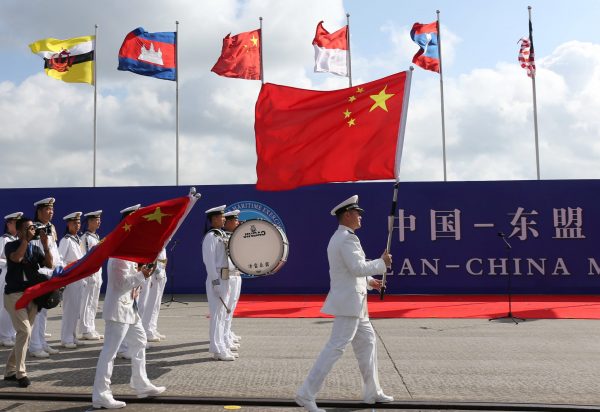The Single Draft South China Sea Code of Conduct Negotiating Text (SDNT) was adopted in August by the foreign ministers of ASEAN and China. The SDNT includes proposals for areas of cooperation and for dispute prevention, management and settlement mechanisms in the South China Sea among the parties.
While the SDNT is a major step forward, several points of contention remain, including the geographic scope of the eventual Code of Conduct (COC), preferred dispute settlement mechanisms, and details of resource exploration and development. Final agreement on an effective COC still seems some way off.
Still, Chinese Premier Li Keqiang has committed Beijing to completing negotiations on the COC within three years. The chairman’s statement of the 33rd ASEAN Summit in November notes that ASEAN member states welcome the improving cooperation between ASEAN and China, and are encouraged by the progress of the COC negotiations on a mutually agreed timeline.
Other positive developments include the ASEAN–China maritime exercise in October and the November launch of the China–Philippines framework agreement to pursue cooperative petroleum exploration in the West Philippine/South China Sea. These events are symptomatic of improving relations between China and ASEAN.
China is clearly trying to rebuild its image in the region. Its olive branch to its ASEAN neighbours is evident in a range of initiatives, including through its agreement to pursue negotiations on the COC.
The spillover of deteriorating US–China relations into the South China Sea was the main source of instability in the contested waters this year. The United States is seeking to maintain strategic domination of the region while China is increasingly challenging that domination, pushing back against what it sees as US attempts to contain it.
In March and April, both China and the United States undertook extensive naval exercises in the South China Sea. China’s exercises involved its aircraft carrier and more than 40 warships, while the United States had three aircraft carrier battle groups exercising in the area at separate times. Later in the year it was reported that the US Pacific Fleet had drawn up plans to carry out a major show of force against China. Though this did not eventuate, two US Navy aircraft carrier strike groups teamed up for exercises in the Philippine Sea in November — a relatively rare gathering of naval power in the Western Pacific.
China continued to upgrade its facilities on its features in the South China Sea, including a new platform on the previously unoccupied Bombay Reef in the Paracel Islands. Tensions further escalated with the reported installation of anti-ship cruise missiles and surface-to-air missiles on three of its claimed features in the Spratly Islands.
China also continued robust actions to enforce its claims in the South China Sea. In April, Chinese coast guard vessels chased Vietnamese fishing boats near Lincoln Reef in the Paracels, and rammed and sank one of them. In May, a Philippine Navy ship was harassed by two Chinese vessels while conducting a resupply mission to a grounded Philippine Navy ship at Second Thomas Shoal.
Meanwhile the United States continued its program of freedom of navigation operations (FONOPs) off Chinese claimed features in the South China Sea, with four operations so far in 2018. In September, in the most newsworthy incident of the year, a Chinese destroyer came close enough to the US guided-missile destroyer USS Decatur to allegedly force the latter vessel to alter course. The Decatur at the time was conducting a FONOP within 12 nautical miles of the Gaven and Johnson Reefs in the Spratlys.
The United Kingdom joined the FONOP game in August when HMS Albion, an amphibious assault ship, sailed through China’s claimed territorial waters around the Paracels. The purpose of the operation appears to have been to challenge China’s claim to enclose the Paracels within straight baselines contrary to international law.
While the Albion FONOP drew the expected strong response from China, it was a ‘soft’ operation compared to most US FONOPs in the South China Sea. Unlike the FONOP conducted in May when two US Navy warships sailed within 12 nautical miles of several Paracel islands, press reports suggest Albion did not enter inside 12 miles of any island.
It’s unclear whether FONOPs by extra-regional countries as a push-back against China in the South China Sea are serving any useful purpose. They may actually be destabilising a situation that is looking increasingly more stable. FONOPs add to the strategic distrust and tensions that continue to prevent effective management of the South China Sea and activities within it. As Malaysian Prime Minister Mahathir Mohamad argued in June, ‘I think there should not be too many warships. Warships create tension’.
The key challenge in 2019 will be to keep up the momentum of the COC negotiations. That’s the responsibility of ASEAN and China. As for extra-regional countries, they should be more restrained and let the ‘locals’ get on with looking after their own backyard.
Sam Bateman is a Professorial Research Fellow in the Australian Centre for Ocean Resources and Security (ANCORS) at the University of Wollongong. He is on Twitter at @sculler33.
This article is part of an EAF special feature series on 2018 in review and the year ahead.

